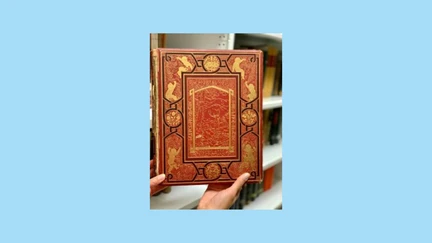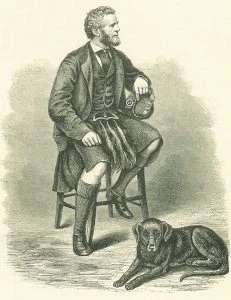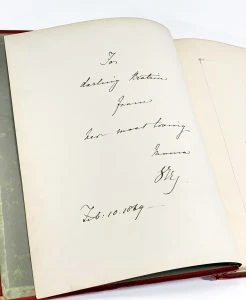From the Rare Book Collection: Queen Victoria’s signed copy of her published journals
Only a few British monarchs have ever written books. As a young king, Henry VIII published an attack on the Protestant reformer Martin Luther many years before his own split with the Catholic church.

Eight decades later, James IV of Scotland (later to become James I of the newly formed United Kingdom) wrote a variety of works including an epic poem, a treatise against tobacco and a study of witchcraft and demonology which was later used by William Shakespeare as one of his main sources for Macbeth. However, only one monarch has ever published what essentially is an autobiography during their life; Queen Victoria and her book Leaves from the Journal of Our Life in the Highlands.
Queen Victoria reigned for nearly 64 years following her coronation in 1837. In 1842 when she was aged 23, she and Prince Albert travelled to Scotland for a holiday shortly after marrying. Their experiences on that trip made a lasting impression on them both and she soon became the first monarch since Charles I to have a home in Scotland. Victoria and Albert returned in 1844 and again three years later. In 1848 Albert acquired a lease on Balmoral Castle and its associated estate of 17,400 acres in the Deeside region, about 80 km west of Aberdeen and then purchased it using his own inherited wealth in 1852. In due course this isolated area was to become Victoria’s spiritual home and she returned there with her family almost every year for the rest of her life. These retreats allowed the royal couple to cast off much of the rigid formality of court protocol and to gain some sense of what it might be like to live a ‘normal’ life. Victoria and her family would roam the hills and explore the wild mountain streams as they chose.

Victoria & Albert’s cottage retreat at Balmoral
Following Prince Albert’s death in 1861 aged only 42, Victoria fell into a period of deep depression. Her trusted Scottish servant and guide, John Brown, took it upon himself to help the queen in overcoming her grief and he encouraged her to write about her earlier holidays as part of this process. Their close (and controversial) friendship was subject to much speculation and the nature of the relationship has been dramatised several times, most notably in the 1997 film, Mrs Brown.

Queen Victoria’s Scottish servant and confidant, John Brown
Victoria’s journals were edited and published privately in 1867 as Leaves from the Journal of Our Life in the Highlands and distributed to family and close friends as gifts. Her family was so delighted that the following year Victoria was persuaded to issue a second edition of the book for general publication. Much to the surprise of the queen, the book became an immediate best-seller. One unintended consequence of its success was that Deeside became a tourist destination for royal watchers and so the movements of the vacationing royal family around the area became restricted with increased security concerns.
Victoria’s writing style is gentle, unpretentious, often amusing, and at odds with the dour image commonly associated with her. The queen’s attention to detail gives a fascinating insight into her thoughts and reflections as a wife and mother. Accompanying the text are stunning engravings and coloured plates of scenes from Balmoral and the surrounding area as well as reproductions of simple sketches by Victoria and Albert. As befitting a queen, the book was produced to the highest standards of the day using the latest lithographic printing technology.

The dedication to Princess Beatrice by her mother, Queen Victoria .
However, what makes this copy of the 1868 edition so significant is that it was personally inscribed, signed and dated by Queen Victoria as a gift to her youngest child, Princess Beatrice, when she was 11 years old. Born only four years before her father’s death, Beatrice had by far the closest relationship with her mother out of any of her eight siblings. As her elder sisters were gradually married off into other European aristocracies, the queen insisted that her youngest daughter remain by her side. Though Beatrice married in 1885, the marriage was only agreed to by Victoria on the condition that she and her husband remain living in the same household as the queen. Following Victoria’s death in 1901, Beatrice spent the next 30 years transcribing and editing her mother’s journals and diaries, adhering to her instructions that anything causing embarrassment to others be removed. She died in October 1944 at the age of 87, having outlived her husband by nearly 50 years. She also outlived all of her siblings and their spouses, two of her children, and her three most famous nephews, Kaiser Wilhelm II of Germany, Tsar Nicholas II of Russia and George V of the United Kingdom.

Princess Beatrice’s bookplate bearing her coat of arms pasted inside the front cover of the book.
How the book ended up in Wellington is an interesting story in itself. It was acquired (possibly in a charity auction following Beatrice’s death) by Colonel A.H. Rowen and his wife. She was the daughter of the prominent Wellington businessman David Nathan, but had lived in England for many years. On a vacation back to New Zealand in 1953, the couple decided to gift the book to the city of Mrs Rowen’s birth and in a special ceremony it was handed to the mayor of Wellington, Sir Robert Macalister. The book was subsequently transferred to the rare book collection of Wellington City Libraries. With the Central Library currently closed, the volume is being carefully stored in a custom-made acid-free enclosure in a temperature and humidity controlled room at the Wellington City Archives.